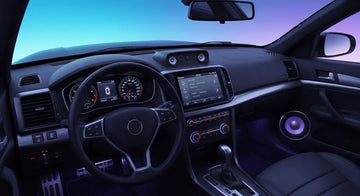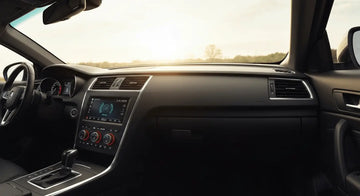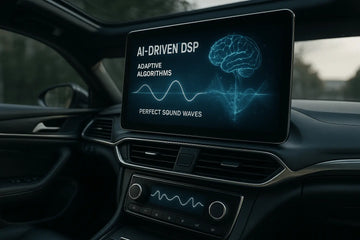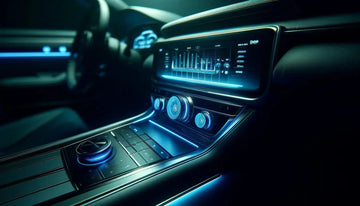Key Highlights
- Car audio enthusiasts and professionals utilize processor DSP systems for an optimal sound experience.
- They offer advanced features like time alignment, equalization, and digital crossovers.
- Understanding your car's audio system needs is crucial for choosing the right DSP.
- Essential equipment includes the dsp unit, amplifiers, and appropriate wiring.
- Car audio enthusiasts and professionals utilize DSPs for optimal sound experiences.
Introduction
In car audio, getting clear sound quality means using digital signal processing, or dsp applications, which are applicable in a variety of applications. DSP technology lets you control and improve audio signals very precisely. This makes your listening experience much better. This blog will look into how car audio processors work with DSP. It will help you make better choices about upgrading your car's audio system.
Understanding Car Audio DSPs
Car audio systems can have problems with sound quality. This is usually because of where the speakers are placed, the sound inside the car, and other reasons. Regular audio parts like head units and amplifiers often do not solve these problems well.
That's where a car audio processor dsp is helpful. These smart devices work like the brain of your car's audio system. They take the audio signal from your head unit and use advanced signal processing to improve the sound quality.
What is a Car Audio Processor DSP?
A car audio processor, or DSP, stands for digital signal processor. It is a special device made to improve the audio signals in your car. It takes the basic sound from your head unit and refines it. This results in a clearer and more enjoyable listening experience.
The real strength of a car audio processor is in its DSP functionality. These processors use advanced algorithms to fine-tune different audio settings, like equalization, time alignment, and crossover points, very accurately.
By carefully adjusting these settings, a DSP can fix issues caused by where your speakers are, the sound inside the cabin, and even the style of music. This way, it provides audio that fits your tastes and the unique sound of your car.
The Role of DSP in Enhancing Car Audio Systems
One important use of DSP is to solve the problems with old analog devices in car audio systems. While analog parts like crossovers and equalizers can work, they do not match the accuracy and flexibility of digital devices.
DSPs can smoothly switch between different frequency ranges. This helps each speaker in your car get the best frequency range for great performance. As a result, you hear clearer highs, more defined mids, and stronger, deeper bass.
Also, DSPs team up with amplifiers to improve the audio signal even more. They carefully control the signal sent to each amplifier channel. This ensures that every speaker gets a clean and clear signal, unlocking the full power of your car audio system.
Getting Started with Car Audio DSPs
Exploring car audio DSPs can offer many ways to customize your sound. Yet, it might feel overwhelming for those new to it.
This section will help you understand the basics. We will cover the equipment you need and help you identify what you want from your car audio system. This will make everything easier and less scary.
Essential Equipment and Tools
Before you start working on car audio DSPs, you need to gather some tools and equipment. This will help you install everything smoothly and make sure your DSP system works well. Here’s a list to help you:
- DSP Unit: This is the key part of your system upgrade. Pick one that has the features and power you need for your audio plans.
- Amplifiers: Depending on how complex your system is, you will need one or more amplifiers to power your speakers.
- Wiring: It's important to use high-quality wiring. This helps send audio signals clearly without any loss or issues.
- Converters: You will need these if your head unit or amplifiers do not have the right digital inputs or outputs.
Also, knowing about car audio systems and some basic wiring can be very useful.
Identifying Your Audio System Needs
Identifying your audio system needs is crucial for selecting the right DSP and maximizing its potential. Consider your listening habits, desired sound quality, and the limitations of your car's acoustics.
Do you prioritize clarity for vocals, a punchy bass response, or a balanced soundstage? Understanding your preferences will guide you towards DSPs with specific features and processing power.
Here's a simple table to illustrate how DSP power, measured in MIPS (Millions of Instructions Per Second), relates to real-world applications:
|
MIPS |
Applications |
|
Low |
Basic equalization, time alignment, simple crossovers |
|
Medium |
Advanced equalization, multi-way crossovers, sound enhancement |
|
High |
Professional-grade audio processing, extensive customization |
This table provides a general guideline; the ideal MIPS level for you will depend on the complexity of your desired setup and the processing demands of your chosen features.
Car Audio Processor DSPs change the way you enjoy music in your car. They help adjust sound quality to fit your preferences. Knowing how they can improve your audio system is important for getting the best setup. By figuring out what your system needs and choosing the right tools, you can really upgrade your in-car entertainment. Discover the benefits of Car Audio Processor DSPs and find a new level of listening pleasure. Are you ready to improve your car audio? Check out how to make your driving music better today!
Frequently Asked Questions
What are the benefits of using a car audio processor DSP in your vehicle?
A car audio DSP changes your car's sound using special signal processing and smart DSP algorithms. It controls audio signals digitally first. Then, it turns them back into analog form. This process makes your sound clearer, better balanced, and deeper. It improves how you enjoy music in your car.





